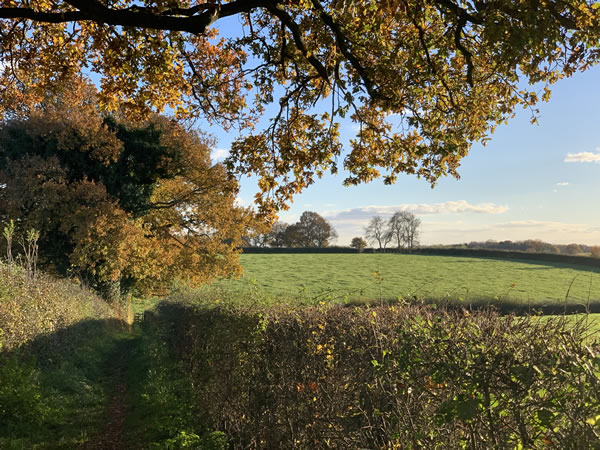 At this time of year after 'excessive and continued' rains, several major Rivers are prone to breaching their banks. Especially the Trent around Derby and the upper reaches of the Thames. The accepted flood plain regions. However, this is a result of the river basin in total - and thus we need to look further upstream to see how this 'inundation' has developed.
At this time of year after 'excessive and continued' rains, several major Rivers are prone to breaching their banks. Especially the Trent around Derby and the upper reaches of the Thames. The accepted flood plain regions. However, this is a result of the river basin in total - and thus we need to look further upstream to see how this 'inundation' has developed.
Many commentators speak of problems with 'dredging and clearing waterways', sure this will {update- probably NOT[1]} help - but a major contributory factor has been overlooked, and something that was so common in the past that these so-called floods rarely occurred. This is the buffering aspects 'upstream' due to woodlands and hedges on our hill sides - to slow down the dumping of water within the water course(s). This is echoed, nicely with the extracts below from Erica Gies - who is advocating for a "Slow Water Movement"
Over the years, due to the partial 'industrialisation' of farming {as a business - rather than as custodians of the land} we have witnessed the removal of hedges, woodland strips, woodlands and other aspects that contributed to keeping water within the land itself. The fields that the farmers are utilising have become appreciably larger - by the removal of hedge-rows and woodland strips.
However research shows that this policy of "enlargement" carries additional risks in terms of rainfall interception: See full Research Here - CLICK
"Hedgerows can intercept a substantial fraction of the rainfall that would have fallen onto their projected ground area without their presence. The interception loss in two hedgerows in southern England was found to be 50–60% of gross rainfall in the summer and 40–50% of PG in the winter if related to projected ground area. In regions with climates characterised by high windspeeds, wind-driven rainfall plays a major role in the hydrology of hedgerows."
"A rainfall shadow of a width similar to the height of the hedgerows is found downwind of them and some rainfall concentration can occur near their upwind edge. The analytical model of rainfall interception (Gash, 1979), which was previously used for extensive forests, can be parameterised for hedgerows and reliably predicts their interception loss on the basis of daily rainfall data."[2]
These intercept number are highly significant - 50% of the rainfall. Therefore without these hedgerows that rainfall is draining from the land and into the water courses - and onto our Rivers. The situation with multiple hedgerow removal has to be considered too.
[1] Slow Water Down - not Speed it up! The slow water movement is about empowering individuals and communities, as well as governments, to help restore earth’s water cycles. Here is Erica Gies website where you can find out more. https://slowwater.world See the Read More Section too;
[2] Measuring and Modelling the Rainfall Interception Loss by Hedgerows in Southern England: Mathias Herbst, John M. Roberts, Paul T.W. Rosier, David J. Gowing: The Open University, Department of Biological Sciences: Received 9 June 2006; received in revised form 22 September 2006; accepted 23 October 2006.
Growing up, Erica Gies swam outdoors, and grew to love the wildness of water. As a journalist for the the New York times, working on the renewable energy beat, she wrote two articles about the nexus of energy issues and water, that pivoted her focus, and got her hooked on writing about the topic of water.
She began investigating the perils of the our current infrastructural approaches to water, looking at how ‘grey infrastructures’ often exacerbate the problems, like floods and droughts, that they are trying to solve. She also started exploring the benefits of ‘green infrastructure’, nature-based solutions for water.
Levees, a form of grey infrastructure built to stop floods, can also have the unintended consequence of faster rivers, more flooding downstream of the levee, and bigger floods when the levees finally do break. Restoring our floodplains is a nature-based solution that provides better protection against floods, and also has positive ripple effects for the whole water cycle. These nature based solutions are beginning to be implemented in places like Seattle, where the utility company has been buying back land from homeowners properties which have flooded, and turning that land back into floodplains, and in places like just outside of Sacramento, where the Yolo bypass has been turned into a part time farmland, and a part time floodplain, that the rivers can overflow into when big rains hit California.
Dams are a form of grey infrastructure that are not necessarily as good at providing water for society as we may think. It also has unintended consequences. Erica Gies cites a research study which shows that while dams provide more water for 20% of the worlds population, they also lead to less water for 24% of the world’s population. She talks about the Reservoir Effect, which is the phenomena where as more water is provided for a location, more people and businesses move there, which then creates more water needs there. That keeps those areas in perpetual worry around water scarcity issues. The transport of water from dams can also be very energy intensive - California spends a fifth of its state’s energy moving and cleansing water.
Erica Gies speaks of some of the underlying causes of wildfires not discussed as much by the media. One cause is that logging means less moisture is held in the land, which means less evapotranspiration to cool the land, which means hotter lands and more wildfires.
A second cause is that the draining 87% of the world’s wetlands means there is less water to stop fires. It also means less water is funnelled into aquifers, which means less groundwater can be brought up by trees in the dry season to hydrate the landscape. A third cause is that the clearing our forests of undergrowth and dead wood can sometimes counter-intuitively lead to more wildfire. This is because the undergrowth, the dead logs, and the rich soil, hold a lot of moisture that protect the forest against fires - this according to a study Erica Gies cites. (I heard recently a leading atmospheric scientist discuss how wildfires are happening at a much higher rate than their climate models would predict. This may be because they are not including some of the above causes into their climate models.) Restoring our wetlands, replenishing our aquifers, lessening logging, regrowing polyculture forests rather than monoculture forests, and bringing back beavers, are some of the nature-based solutions to preventing wildfire.
With her talent to cogently elucidate, Erica Gies has been writing about water for magazines and newspapers like Scientific American, National Geographic, Nature, and the Guardian. In 2022 her book “Water always wins” came out, which looks at water problems and solutions in places like Chennai, Mekong, California, Iowa, Kenya, Peru and China. It’s a panoramic book that gives us a sense of the state of water on planet earth, and what we can do to move forward in a healthy way. The book has been garnering many accolades, including the Rachel Carson award from the Sierra Club.
Here’s what the Times Literary Supplement wrote about her book : “Our desire to control and insupportably consume water has caused irregular weather patterns, shortages and humanitarian disasters on a global level. How can we change our approach to water before it causes further harm, as with Hurricanes Katrina, Sandy and Ida, or with the devastating Syrian drought, which lasted from 2006 to 2010 and was abetted by agricultural and irrigation projects? This question underpins Gies’s comprehensive research as she journeys across the globe in search of “water detectives”: those who uncover what the element did, how it acted and what it “wanted” before it had to navigate our man-made management systems, which circumvent its established routes. Along the way we meet pioneering researchers, academics, activists and leaders who look beyond the “shifting baselines” of their generation, at past topographies, for clues regarding water’s old habits and routes. We learn why certain areas flood repeatedly, and how our tendency to speed water off the land deprives us of “urgently needed rainfall”. Blueprints of marshlands, creeks and rivers from more than 2,000 years ago, it turns out, offer safer, more sustainable methods of irrigation – what the author calls “Slow Water Techniques”.
Here’s an excerpt from ‘Water Always Wins’:
“our curiosity about water’s true nature is not idle, nor an indulgent wish to return to the past. Water seems malleable, cooperative, willing to flow where we direct it. Water is increasingly swamping our cities or dropping to unreachable depths below our farms, generally making life—ours and other species’— precarious.
Signs of water’s persistence abound if we train ourselves to notice them. Supposedly vanquished waterways pop up stubbornly, in inconvenient ways. In Toronto, tilted houses on Shaw Street near the Christie Pits neighborhood were long a local novelty, but most people didn’t know that the ghost of Garrison Creek was pulling them out of plumb. Worldwide, seasonal creeks emerging in basements are evidence that those houses encroach on buried streams.
In my partner’s mom’s neighborhood in suburban Boston, all the houses come with sump pumps because the development was built on the local “Great Swamp.” And in the wreckage of disasters like Superstorm Sandy or Hurricane Harvey, we see that homes built atop wetlands are the first to flood.
When our attempts to control water fail, we are reminded that water has its own agenda, a life of its own. Water finds its own path through a landscape, molding it and being directed in turn. It has relationships with rocks and soil, plants and animals, from microbes to mammals like beavers and humans. Today, water is revealing its true nature increasingly often, as climate change brings more frequent and severe droughts and floods. To reduce the impacts of these phenomena, water detectives—Pomerantz and other ghost-stream enthusiasts, restoration ecologists, hydrogeologists, biologists, anthropologists, urban planners, landscape architects, and engineers— are now asking a critical question: What does water want?”
[In Chinese, Erica Gies’s book was translated with the title “Slow Water”, which is what she was going to originally title her book.]
To heal our water cycle, Erica Gies proposes the creation of a slow water movement, which advocates for the slowing of the flow of water through our landscapes. In this way we can hydrate our landscapes better, rivers will run year round more, groundwater can replenish, the small water cycle (precipitation recycling cycle) will be healthier, and more water from the wet season can still be in the ecosystem into the dry season. It would help with floods, droughts, fires, and heat waves. She sees the slow water movement as being decentralized, local unique, and socially just.
I love this idea. I’ve also added the suggestion that we can also have local slow water circles, where people gather to read books and watch videos about slow water, and then go out and do slow water projects in their neighborhood.
She talks about some of the things individuals can do to help slow water - implementing rain gardens, converting your lawn to native plants, putting in green roofs, creating rain infiltration points, creating bioswales, and turning driveway to be more permeable. People can also participate in local planning processes, and local water restoration groups.
The slow water movement is about empowering individuals and communities, as well as governments, to help restore earth’s water cycles.
Here is Erica Gies website slowwater.world where you can find out more. https://slowwater.world
